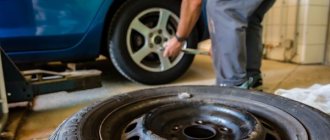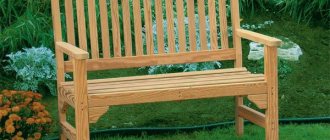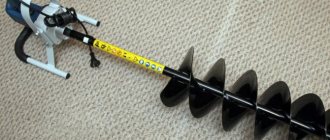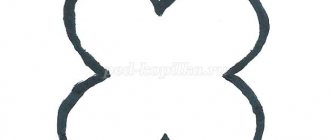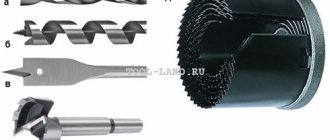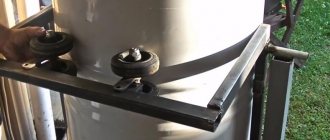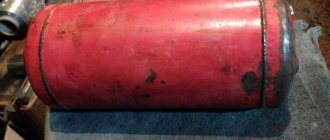How to pull small trees and shrubs out of the ground, the easy way. Make your own simple uprooter of bushes and small trees using an adjustable wrench.
Products for inventors Link to the store.
In recent years all my local woods and gardens have become home to a huge number of shrubs. Shrubs will drown out any other plants and take over the entire area, if left unchecked, everything must be kept under control. A device was needed to remove small trees without much effort. As a result, several different ideas were developed. As a student, I decided to create my own tool for uprooting trees and bushes!
What can you do with an uprooted stump?
The butt and roots are made of wood, so you can use them to make :
- wood chips;
- fuel briquettes;
- firewood;
- furniture;
- crafts.
More detailed information about the use of uprooted and in-ground stumps, as well as methods for working with this material, can be found here (use of stumps).
Uprooting trees
| Service (equipment used) | Price |
| Uprooting trees and shrubs (mounted uprooters). Clearing the field of small forests | 20,000 rub. per hectare |
| Wood waste shredding (mounted shredders) | 20,000 rub. 8 hours per shift |
When a large plot of land is idle for a long time, various trees grow on it and digging them out is a labor-intensive and thankless process. Initially, it seems that they will not interfere much on the site, but a large number of them will complicate the process. It is also worth considering that in the future they will grow to large sizes and it will be much more difficult to remove them.
Important Points and Precautions
There are several rules that apply to the manual uprooting method. Next we will look at the most significant of them.
Who can carry out such work?
This is very hard physical work, involving enormous loads.
Trust uprooting only to physically strong men .
Otherwise, short-term overload or prolonged stress can lead to a hypertensive crisis and other health problems.
Removing wood debris from dry soil
To uproot a stump from dry soil, water the soil around it 1-2 times a week for a month . Pour out 2-4 buckets of water, which will allow the moisture to penetrate even into the deep layers of the soil and make them softer.
To improve the water supply to deep layers, use a pick or crowbar to make 5–15 holes 10–20 cm deep in the ground around the tree. Thanks to this, during irrigation, more water will reach the deeper layers of the soil.
Features of using a winch
Be careful with a winch or hoist - if you attach them incorrectly to a living tree, the tree may become sick or die due to damage to the bark.
In addition, core rot in the first years does not manifest itself externally, but a powerful lateral force from the hoist can break it.
Even a healthy tree will hurt due to the disruption of the soil structure around the roots if there is too much lateral load, so after uprooting, water it generously with water . Excess moisture will make the soil mobile, and the soil will fill all the resulting voids.
Features of work performed near buildings
If you need to remove a stump near your house, use a chemical method, because manual removal leads to slight soil movements , which causes small voids to form under the foundation. In combination with frost heaving, this can lead to a fracture of the foundation and cracking of the walls.
In what weather should you uproot the remaining trees?
Uproot stumps only on dry, windless days . Do not work in the rain - slippery ground increases the risk of falling and injury.
Do not work during strong winds - pieces of earth or wood debris may get into your eyes.
Also, you should not uproot in the dark - an ax, crowbar and shovel in poor visibility conditions can cause serious injuries.
Be careful when working with any tool , do not cause injury to yourself, assistants or those who happen to be nearby.
Varieties of uprooters
There are several types of manual weed extractors. We invite you to familiarize yourself with their types, which will allow you to choose the most suitable option for yourself.
garden fork
Using a garden fork, you can remove a weed with a fairly developed root system. But this is provided that the fork teeth are bent at an angle of 45º or more. If they are bent less than 45º, then it is suitable for loosening the soil and removing weeds with a weak root system.
When choosing a garden tool, it is important to pay attention to ease of use. The handle of the equipment should be comfortable, so you can avoid pain in the hand.
Root remover for gardening
Using a root remover, you can remove weeds with deep roots from the ground. Such devices come in a wide variety. Some have a sharp V-shaped blade, others look like a fork with 2 flat and wide teeth, and there are also models that resemble a huge corkscrew in appearance.
Crevice weed clearer
The slot weed extractor has an L-shaped blade. With its help, it is convenient to clear the weeds from the space between the tiles that are usually used to lay paths. For the same purposes, an ordinary kitchen knife is often used.
Types of manual wood removal
When manually removing wood, the following types of uprooting are used:
- removal of a stump with lateral roots;
- removing a stump without roots;
- removal of thick roots.
The main difference between manual uprooting and mechanized uprooting is the limited possibilities for influencing the stump and roots, so it is rarely used for complete removal of roots .
After all, many trees have upper roots that stretch for tens of meters, and their thickness often exceeds 5 cm.
To remove roots, you have to dig not only a hole around the trunk , but also dig a trench around each root , so it’s easier to hire a tractor to quickly do this work.
With lateral roots
This uprooting method is used where some other plant needs to be planted instead of a healthy tree that has been cut down . For example, when expanding a site, it is necessary to cut down the trees enclosing it, which protected the soil from air erosion and improved the water regime of the soil.
If a diseased tree is removed, then the following type of uprooting must be used, because it allows not only to remove the root system, but also to destroy the causative agents of root rot and other diseases.
Here is the procedure that needs to be carried out for such uprooting:
- Draw a circle around the stump, the diameter of which is 10 times larger than the diameter of the trunk near the ground, but not less than 1 m.
- Dig all the soil up to the top lateral and horizontal roots. Dig them from all sides.
- Use an ax to chop off the roots near the trunk and as far away from it as possible. Be careful - you need to place your feet so that the ax that jumps off the wood does not cause injury to you. If the lateral roots are too thick, then you need to dig them up so that there is 5–10 cm between them and the ground, then cut them with a hacksaw or chainsaw. When working with a chainsaw, remember that even a small piece of earth, if it gets under the chain, greatly dulls it.
- Dig a hole in the same way until its depth reaches five times the diameter of the trunk, but not less than 1.5 times the depth of the hole required for planting a new tree.
- Shake the stump, if it elastically moves 2–3 cm or more, then you have removed all horizontal and lateral roots, so it can be trimmed. If it stands rigidly and can only be moved a few mm, it means that there are several more rows of horizontal or even lateral roots. In most cases, the stump of even a healthy tree, the main root of which is cut down at such a depth, no longer produces shoots, but there are exceptions. Therefore, it is necessary to decide what to do next: go deeper to remove the lateral roots, cut down the vertical root and remove the stump, hoping that it will not sprout anymore, or cut down the vertical root and burn the root system remaining in the ground to ensure that shoots do not grow.
- Cut the main root as close to the ground as possible. If you can’t cut it, try tilting the stump with a crowbar and cutting from the bend side.
- If there is no main root, then dig up the bottom row of lateral roots and cut them off at the maximum distance from the root. Then insert a crowbar under them and turn out the stump.
Features of using crowbar and winch or hoist
Instead of a crowbar for uprooting, you can use a winch with a force of 3–6 tons .
At a distance of 5–10 m from the stump, drive a pin into the ground, leaving 10 cm on the surface, including the heel, then attach a winch to it, and connect the second edge of the winch to a steel loop, which you throw over the stump.
Tighten the loop and pull the winch , while watching the position of the pin. If the roots are dug up and not cut off enough, the pin will come out of the ground.
After removing the stump, pull the pin out of the ground; to do this, place a crowbar and a couple of bricks or a board of suitable thickness under it.
The crowbar forms a lever, the short arm of which is located between the support and the heel, and the long one between the heel and the hands. Raise the crowbar and it will pull the pin out of the ground. This lifting is done from different sides, gradually increasing the height of the lining.
If for some reason it is not possible to use a pin, the winch can be attached to a live tree .
Please observe the following conditions :
- use a tree whose diameter exceeds the diameter of the stump by at least 1.5 times;
- choose only a healthy tree without rot and disease;
- attach the winch to the tree only with a wide nylon, woven or leather belt, for example, from a safety belt;
- attach the winch to the tree as close to the ground as possible, and place the loop on the stump as high as possible.
We root without removing roots
This uprooting method is used only for stumps with a diameter of 10 cm or less , remaining after cutting young trees with superficial or tap root systems .
This method is not suitable for trees with a fibrous root system (birch, apple and others).
It is more effective in cases where, after removing a stump, it is necessary to burn off the remains.
The method is also advisable if you plan to plant bushes with a shallow root system in place of this stump.
Here's the procedure :
- follow steps 1–2 of the previous uprooting method;
- Having reached the horizontal roots, dig them up so that you can chop them off approximately half the distance to the edge of the hole;
- near the cutting site, drive the crowbar under the root and slightly lift it, this will reduce the loss of ax energy caused by vibration upon impact;
- cut off all large and small roots;
- remove the stump with a crowbar or winch as described above.
Elimination of thick roots
After removing the stump, the roots located outside the hole remain.
In most cases, all life processes in them cease and, with sufficient moisture, they rot in 15–30 years.
If the tree has been infected with pathogens, or these roots interfere with construction/repair work, then they are removed in one of the following ways :
- They dig up and cut down the interfering area - this method is applicable to surface roots if they interfere with construction or repairs.
- Poisoned with potassium or ammonium nitrate - this method is suitable for removing diseased roots of any type. After all, saltpeter changes any organic matter, including pathogens, after which they lose their harmful properties. We talked about this method in more detail here.
Basic Tools
For manual uprooting, the following tools are required :
- shovels and bayonet shovels;
- axe;
- wood saw or chainsaw;
- scrap;
- pick;
- pin;
- sledgehammer;
- winch or hoist;
- wide nylon belt;
- steel rope.
These tools will be needed for any type of manual uprooting, so it is advisable to start work on the site by purchasing them.
Most tools are available at your local hardware or hardware store, and the pin can be made from steel reinforcement with a diameter of 15–25 mm .
To do this, you will need a piece of reinforcement 1–1.5 m long (the softer the soil, the longer the pin should be), one end of which is sharpened with a grinder at an angle of 20–45 degrees, and on the other a round heel made of sheet steel with a thickness of 10 and a diameter of 50 is welded. mm.
